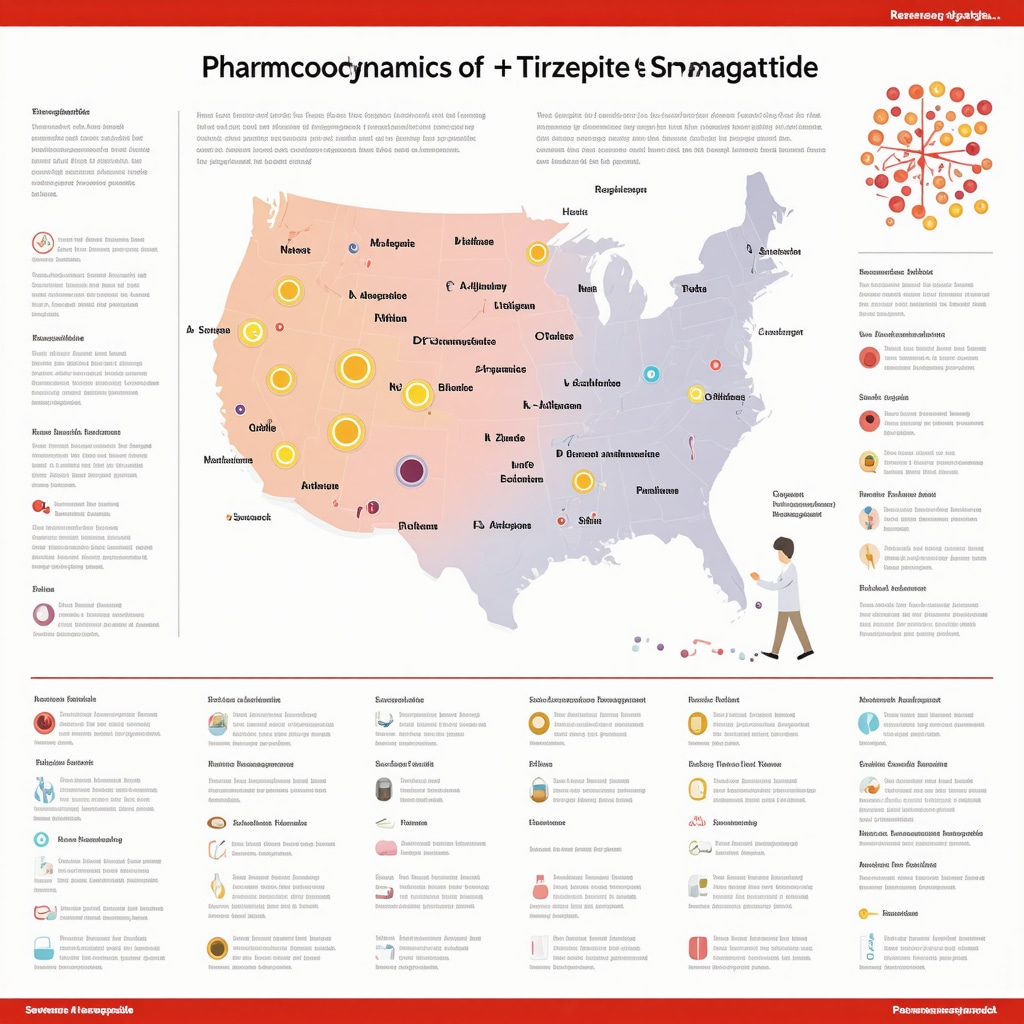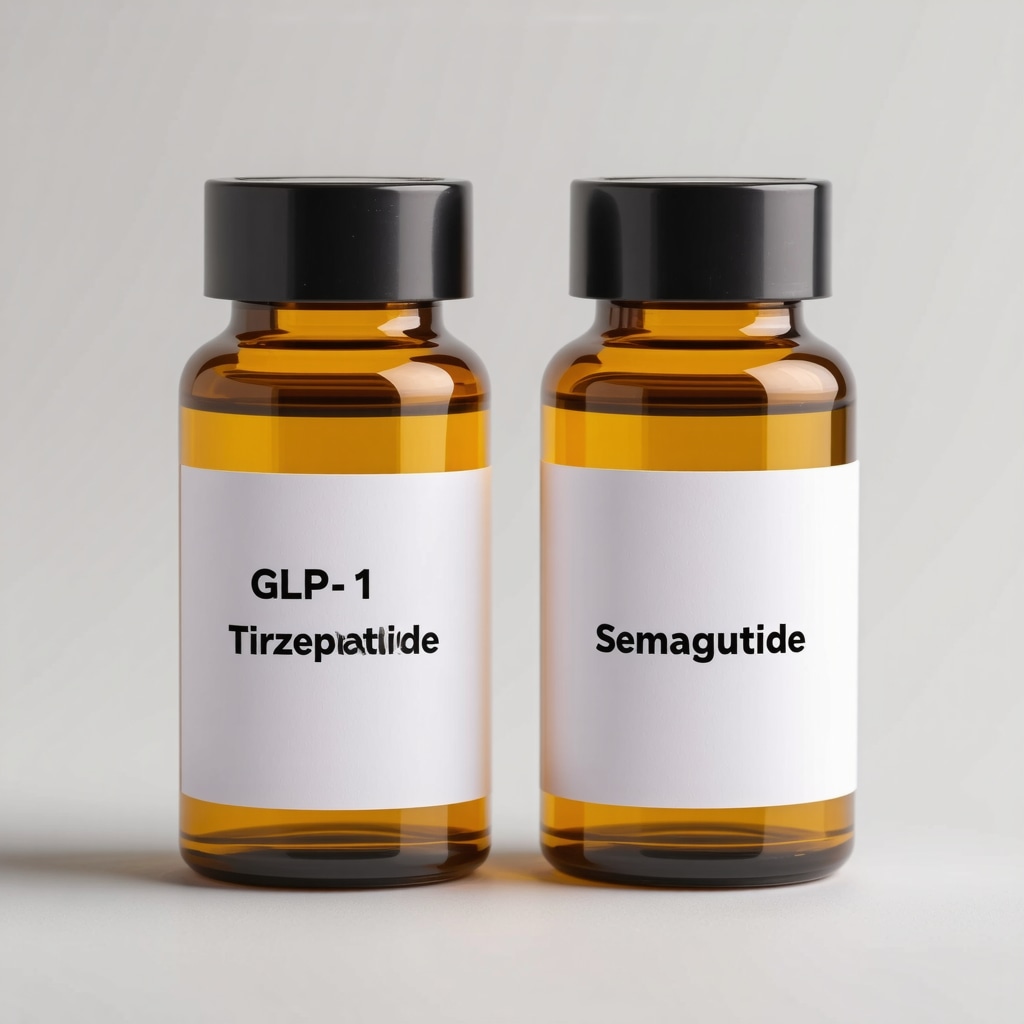Unveiling the Dual Powerhouses: Tirzepatide and Semaglutide in the GLP-1 Arena
In recent years, GLP-1 receptor agonists have revolutionized the landscape of metabolic health, offering promising solutions for type 2 diabetes and obesity management. Among these, Tirzepatide and Semaglutide stand out as groundbreaking injectable medications that harness incretin biology to suppress appetite and improve glycemic control. But how do their benefits truly compare, and what nuances should patients and clinicians consider when choosing between them?
Tirzepatide: The Next-Gen GIP and GLP-1 Dual Agonist
Unlike traditional GLP-1 agonists, Tirzepatide uniquely activates both the glucose-dependent insulinotropic polypeptide (GIP) and GLP-1 receptors. This dual mechanism amplifies insulin secretion and enhances satiety signals more robustly. Clinical trials demonstrate Tirzepatide’s superior efficacy in weight reduction, often surpassing Semaglutide in both the magnitude and speed of fat loss. Patients report not only improved appetite control but also better post-meal glucose regulation, contributing to comprehensive metabolic benefits.
Semaglutide: Proven GLP-1 Monotherapy with Established Safety
Semaglutide has earned a strong reputation through extensive use and research as a selective GLP-1 receptor agonist. Its once-weekly injection regimen facilitates sustained appetite suppression and delayed gastric emptying, promoting meaningful weight loss and glycemic stability. While perhaps slightly less potent in weight reduction than Tirzepatide, Semaglutide’s long track record offers confidence regarding tolerability and manageable side effect profiles.
What Are the Key Differences in Side Effect Profiles Between Tirzepatide and Semaglutide?
Both medications commonly induce gastrointestinal symptoms such as nausea, vomiting, and diarrhea, particularly during dose escalation phases. However, Tirzepatide’s dual receptor action may lead to a higher incidence of these effects initially, necessitating gradual dose titration and close monitoring. Conversely, Semaglutide’s side effects are generally well-characterized, with many patients adapting within weeks. Understanding these nuances allows personalization of therapy to maximize adherence and outcomes.
Integrating GLP-1 Medications Into a Holistic Weight Loss Strategy
Combining these injectable therapies with tailored nutrition and exercise plans significantly boosts efficacy. Expert guidance on balancing diet and injection timing can optimize appetite control and minimize side effects. Resources such as GLP-1 Medication Insights: Tirzepatide vs Semaglutide Benefits offer in-depth strategies for patients navigating these treatments.
Expert Perspectives: Beyond the Numbers
Practitioners emphasize the importance of individualized treatment plans, factoring in patient preferences, comorbidities, and lifestyle. Real-world case studies reveal that some patients respond better to Tirzepatide’s dual mechanism, achieving rapid fat loss, while others benefit from Semaglutide’s steady and consistent effects. Ongoing clinical trials continue to elucidate long-term outcomes, informing future guidelines.
For those considering these therapies, staying informed about safety protocols and best practices is crucial. Explore safe use of Semaglutide and effective use of Tirzepatide to enhance your treatment journey.
If you have experiences or questions about GLP-1 medications, feel free to share them in the comments below or contact us for personalized advice.
According to a recent review published in The New England Journal of Medicine, Tirzepatide exhibits notable improvements in glycemic control and weight loss through its unique dual agonism, illustrating a promising advancement in the pharmacotherapy of metabolic disorders.
Learning from the Journey: My Personal Encounters with GLP-1 Therapies
When I first started exploring weight loss through injectable medications like Tirzepatide and Semaglutide, the science fascinated me, but it was the day-to-day experience that truly shaped my understanding. Early on, I noticed that while Tirzepatide offered rapid appetite suppression, the initial gastrointestinal side effects required patience and careful dose adjustments. In contrast, Semaglutide’s gradual onset felt gentler, allowing me to adapt my lifestyle steadily. This personal journey resonates with many patients’ experiences, highlighting the importance of a tailored approach.
Beyond Medication: How Lifestyle Choices Amplify Results
One of the biggest lessons I’ve learned is that these medications are tools, not magic bullets. Incorporating balanced meals rich in fiber and protein alongside consistent physical activity made a world of difference. For example, I found that timing my injections to coincide with my meal schedule helped curb cravings more effectively, a strategy supported by experts in the field. If you want to dive deeper into the science and practical applications, check out this guide on combining diet and injectables that really helped me optimize my regimen.
What strategies can you share that helped you manage injection side effects or stay motivated during your weight loss journey?
Sharing stories and strategies creates a supportive community, and I’m genuinely curious about your experiences. Have you found particular foods that ease nausea, or perhaps routines that keep you consistent with injections? Your insights could be invaluable for others navigating similar paths.
Understanding the Science: Why Dual Agonism Matters
Reflecting on the pharmacology, Tirzepatide’s dual agonist activity intrigues me because it targets both GIP and GLP-1 receptors, which explains its enhanced efficacy in fat loss and glucose regulation. According to a comprehensive review in The New England Journal of Medicine, this dual mechanism represents a significant advancement in metabolic therapy. Knowing this helped me appreciate why some patients experience faster results and guided my discussions with healthcare providers.
Practical Tips for Injection Site Care and Pain Reduction
Managing injection site reactions was a learning curve. I discovered rotating injection sites, using proper needle techniques, and pre-injection skin care were game-changers in reducing discomfort. For anyone starting out, I highly recommend exploring these doctor-approved tips that clarify how to keep your skin healthy and minimize pain. This not only improved my comfort but also my confidence in managing my treatment independently.
If you’re currently using or considering these injectable therapies, I encourage you to comment below with your experiences or questions. Let’s build a community where we learn from each other and make the journey smoother for everyone.
Decoding the Pharmacodynamics: How Dual and Single Agonism Influence Metabolic Pathways
Diving deeper into the molecular intricacies, Tirzepatide’s dual activation of GIP and GLP-1 receptors orchestrates a synergistic modulation of pancreatic beta-cell function and adipose tissue metabolism. This dual receptor engagement not only enhances insulinotropic effects but also modulates lipid metabolism more comprehensively than GLP-1 monotherapy alone. By contrast, Semaglutide’s selective GLP-1 receptor agonism primarily influences glucose-dependent insulin secretion and gastric motility, contributing to appetite suppression and glycemic control with a more targeted receptor profile.
This nuanced difference translates clinically into Tirzepatide’s often faster and greater weight loss responses, but with a potentially more complex side effect spectrum that clinicians must navigate carefully. Understanding these pharmacodynamic subtleties enables personalized therapy selection, optimizing outcomes based on patient-specific metabolic profiles and tolerability thresholds.
Expert Strategies for Managing Gastrointestinal and Injection-Related Adverse Effects
Gastrointestinal (GI) side effects remain a common hurdle during initiation and dose escalation of both Tirzepatide and Semaglutide. Experts recommend a multifaceted approach combining slow titration protocols, dietary adjustments, and supportive pharmacotherapy where necessary. For example, low-fat, low-fiber meals can mitigate nausea and bloating, while scheduled antiemetics have shown benefit in refractory cases.
Injection site reactions, though generally mild, can impact adherence. Techniques such as rotating injection sites systematically, using shorter needles, and applying topical anesthetics pre-injection have demonstrated efficacy in minimizing discomfort. Importantly, patient education on correct injection technique and realistic expectations about transient side effects fosters better engagement and persistence with therapy.
How can clinicians individualize dosing schedules to balance efficacy with side effect management in GLP-1 receptor agonist therapy?
Personalizing dosing regimens involves assessing patient response and tolerability closely during initiation and titration phases. Clinicians may extend dose escalation intervals beyond standard schedules for patients experiencing pronounced GI symptoms, allowing physiological adaptation. Additionally, flexible dosing times aligned with patients’ meal patterns and lifestyle can enhance both efficacy and tolerability. Continuous monitoring through patient-reported outcome measures facilitates timely adjustments, optimizing the therapeutic window without compromising metabolic benefits.
For an evidence-based framework on titration and side effect mitigation, see the detailed guidelines published by the American Diabetes Association, which emphasize individualized patient-centered care in GLP-1 receptor agonist use.
Integrating Real-World Data and Emerging Biomarkers to Refine Treatment Selection
Beyond randomized controlled trials, real-world evidence (RWE) contributes invaluable insights into the long-term safety and efficacy of Tirzepatide and Semaglutide. Large observational cohorts reveal variations in patient adherence, metabolic responses, and side effect profiles that may not be fully captured in clinical studies.
Emerging biomarkers such as fasting insulin levels, adipokine profiles, and genetic polymorphisms in incretin receptors hold promise for predicting individual responsiveness to dual versus single agonist therapy. Incorporating these biomarkers into clinical practice could revolutionize personalized medicine approaches, tailoring treatments not only to phenotype but to molecular signatures.
This frontier of precision metabolic medicine invites clinicians and researchers alike to collaborate in refining therapeutic algorithms, maximizing benefits while minimizing risks for diverse patient populations.
If you are a healthcare professional or patient interested in the latest developments in GLP-1 receptor agonist therapies, consider subscribing to our newsletter for ongoing expert analysis and practical guidance.

Precision Dosing Paradigms: Tailoring GLP-1 Agonist Therapy to Patient Nuances
Delving deeper into individualized management of Tirzepatide and Semaglutide therapies necessitates a dynamic dosing approach that transcends standard titration protocols. Clinicians are increasingly adopting flexible escalation intervals calibrated to patient-specific gastrointestinal tolerability and metabolic response. This bespoke methodology not only mitigates adverse events but also potentiates sustained glycemic and weight loss outcomes by harmonizing pharmacodynamics with patient lifestyle factors.
Unraveling Biomarkers: The Frontier of Predictive Metabolic Medicine
Recent translational research underscores the potential of integrating biomarkers such as circulating adiponectin, GLP-1 receptor expression levels, and polymorphisms in the GIP receptor gene to forecast therapeutic responsiveness to dual versus single receptor agonism. Such molecular insights promise to refine patient stratification, enabling clinicians to preemptively select the optimal agent—Tirzepatide or Semaglutide—thereby maximizing efficacy and minimizing trial-and-error in treatment initiation.
How Can Emerging Biomarkers and Real-World Data Inform Personalized GLP-1 Therapy Selection?
Emerging evidence from cohort studies and genomic analyses suggests that patients exhibiting specific adipokine profiles or genetic variants may experience differential benefits or side effect burdens from Tirzepatide’s dual agonism compared to Semaglutide’s monotherapy. The assimilation of these data streams into clinical decision-making frameworks facilitates a transition from empiric to precision medicine in metabolic therapeutics. Continuous real-world surveillance further elucidates adherence patterns and long-term safety, complementing biomarker-guided stratification.
Harnessing Multidisciplinary Expertise: Collaborative Care Models for Optimized Outcomes
Successful implementation of advanced GLP-1 therapies increasingly depends on multidisciplinary collaboration encompassing endocrinologists, dietitians, behavioral psychologists, and pharmacologists. This integrated care paradigm ensures comprehensive assessment of metabolic, psychological, and lifestyle determinants of treatment success, fostering tailored interventions that address barriers to adherence and optimize therapeutic trajectories.
Engage with Cutting-Edge Research and Community Wisdom
For healthcare professionals and patients eager to remain at the vanguard of metabolic treatment innovation, subscribing to specialized journals and participating in clinical forums is indispensable. Resources like the American Diabetes Association’s Standards of Medical Care in Diabetes provide authoritative, evidence-based guidelines that encapsulate evolving best practices in GLP-1 receptor agonist utilization.
We invite you to deepen your understanding and contribute your experiences or queries on GLP-1 therapies in the comments section below. Together, let’s advance personalized metabolic health strategies.

Frequently Asked Questions (FAQ)
What makes Tirzepatide different from Semaglutide at the molecular level?
Tirzepatide is a dual agonist targeting both GIP and GLP-1 receptors, enhancing insulin secretion and satiety through synergistic pathways. Semaglutide selectively agonizes the GLP-1 receptor, focusing primarily on glycemic control and appetite suppression. This dual receptor engagement in Tirzepatide often results in faster and greater weight loss but may also increase gastrointestinal side effects initially.
How do side effect profiles compare between these two medications?
Both medications commonly cause gastrointestinal symptoms like nausea, vomiting, and diarrhea during dose escalation. Tirzepatide’s dual action may lead to a higher incidence of these symptoms initially, requiring slower dose titration. Semaglutide generally has a well-characterized and manageable side effect profile with many patients adapting within weeks.
Can lifestyle modifications enhance the effectiveness of GLP-1 therapies?
Yes. Combining these medications with tailored nutrition—emphasizing fiber and protein—and consistent physical activity optimizes appetite control and metabolic benefits. Timing injections around meal schedules can further improve outcomes and reduce side effects.
What strategies help manage injection site pain and gastrointestinal adverse effects?
Rotating injection sites, using proper needle techniques, and pre-injection skin care reduce discomfort. For gastrointestinal symptoms, gradual dose escalation, dietary adjustments like low-fat and low-fiber meals, and supportive pharmacotherapy such as antiemetics when necessary can improve tolerability.
How can clinicians personalize dosing schedules to balance efficacy and tolerability?
Clinicians should closely monitor patient response, extend dose escalation intervals if needed, and align dosing times with patient lifestyle and meal patterns. Utilizing patient-reported outcomes aids timely adjustments to optimize therapeutic effects while minimizing side effects.
What role do biomarkers play in selecting between Tirzepatide and Semaglutide?
Emerging biomarkers such as adipokine levels, GLP-1 receptor expression, and GIP receptor polymorphisms may predict individual responsiveness and side effect risk, guiding personalized therapy choice between dual and single agonists.
How does real-world evidence complement clinical trial data for these therapies?
Real-world data capture adherence patterns, long-term safety, and efficacy variations in diverse populations, providing practical insights beyond controlled trials and helping refine patient-centered treatment strategies.
Are there multidisciplinary approaches recommended for managing patients on GLP-1 therapies?
Yes. Integrating endocrinologists, dietitians, behavioral psychologists, and pharmacologists ensures comprehensive care addressing metabolic, psychological, and lifestyle factors, thereby improving adherence and outcomes.
Is one medication universally better, or does patient profile determine choice?
Choice depends on individual patient factors including metabolic profile, side effect tolerance, comorbidities, and personal preferences. Tirzepatide may benefit those needing rapid and robust weight loss, while Semaglutide offers a steady and well-established safety profile.
Where can patients and clinicians find authoritative guidance on GLP-1 therapies?
Resources like the American Diabetes Association Standards of Medical Care provide evidence-based guidelines for safe and effective use of GLP-1 receptor agonists, including dosing and side effect management.
Trusted External Sources
- The New England Journal of Medicine (NEJM): Provides comprehensive peer-reviewed reviews and clinical trial data on Tirzepatide and Semaglutide, elucidating their pharmacology and clinical efficacy.
- American Diabetes Association (ADA): Offers authoritative guidelines on diabetes care, including detailed protocols for GLP-1 receptor agonist titration, safety monitoring, and patient-centered management.
- Diabetes Care Journal: Publishes in-depth research articles and consensus statements that inform best practices for metabolic therapies and integration of incretin-based treatments.
- Endocrine Society Clinical Practice Guidelines: Delivers expert consensus on obesity and diabetes pharmacotherapy, including emerging GLP-1 receptor agonists and dual agonists.
- ClinicalTrials.gov: A repository of ongoing and completed clinical trials providing up-to-date evidence on efficacy, safety, and novel biomarkers relevant to Tirzepatide and Semaglutide.
Conclusion
The advent of GLP-1 receptor agonists, particularly Tirzepatide and Semaglutide, marks a transformative era in metabolic health management. Tirzepatide’s dual GIP and GLP-1 receptor agonism offers enhanced weight loss and glycemic control through complex pharmacodynamics, while Semaglutide’s selective GLP-1 activity delivers proven efficacy with well-understood tolerability. Personalized therapy selection, informed by emerging biomarkers, patient-specific factors, and real-world evidence, is key to optimizing outcomes.
Integrating these injectable therapies with lifestyle modifications and multidisciplinary care fosters sustainable success. Managing side effects through tailored dosing and patient education enhances adherence, empowering patients in their weight loss journeys.
We encourage readers to share their experiences, ask questions, and explore further expert content to deepen understanding of GLP-1 therapies. Together, advancing personalized metabolic medicine can improve lives and inspire continued innovation in this dynamic field.


Reading through the comparison between Tirzepatide and Semaglutide really highlights how personalized medicine is shaping the future of metabolic health management. What’s fascinating to me is Tirzepatide’s dual agonist mechanism—activating both GIP and GLP-1 receptors—which seems to offer faster and more significant weight loss along with better post-meal glucose control. However, the potential for increased gastrointestinal side effects, especially early on, means patients and clinicians need to carefully navigate the dosing process. I’ve noticed that many patients might be tempted to push for quicker results but might risk discomfort if dose escalation isn’t handled patiently.
On the other hand, Semaglutide, with its well-established safety profile and steady appetite suppression, provides a more gradual approach that some might find easier to tolerate in the long run. The article’s emphasis on combining these medications with lifestyle changes such as diet and exercise resonates strongly with me, as those elements are pivotal for lasting success.
I’m curious how others have balanced the trade-offs between efficacy and side effects in their experience or clinical practice. Have any readers found specific coping strategies or dosing schedules that helped maintain adherence, especially for Tirzepatide’s initial gastrointestinal challenges? Insights on integrating patient preferences into this decision also seem crucial for optimal outcomes.
Rachel brings up an excellent point about the delicate balance between Tirzepatide’s heightened efficacy and its gastrointestinal side effect profile. From my observation, one effective strategy for managing these side effects—especially early nausea and discomfort—is very gradual dose escalation combined with personalized dietary tweaks. For instance, patients who space small, low-fat, low-fiber meals and stay hydrated often report better tolerance. Interestingly, aligning injection timing with the start of these meals seems to blunt GI symptoms while maintaining appetite suppression benefits.
Clinicians who actively monitor patient feedback and are flexible in prolonging dose escalation intervals tend to achieve higher adherence rates. This tailored approach respects individual variability in tolerability, which is crucial given Tirzepatide’s dual receptor mechanism potentially intensifying side effects initially.
Conversely, Semaglutide’s steadier onset allows some patients to adapt more comfortably but may require longer commitment for comparable weight loss results. Given this, I think engaging patients in shared decision-making is essential—not just in choosing the drug but in customizing dosing schedules and lifestyle adjustments.
I’d be curious to hear if others have experimented with staggered dose escalations or unique dietary routines that improved their management of side effects, particularly with Tirzepatide. Also, how have patients’ preferences shifted when fully informed about these trade-offs? This could deepen our understanding of optimizing both efficacy and quality of life during therapy.